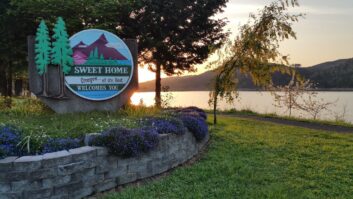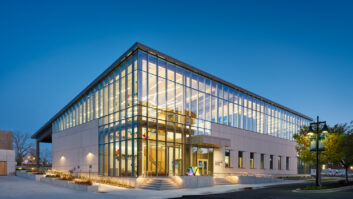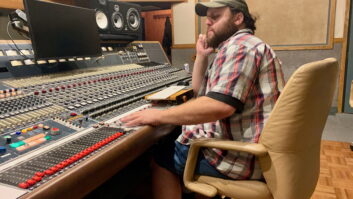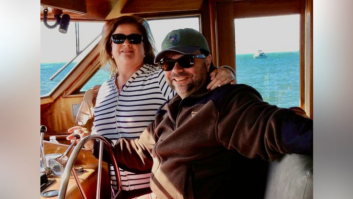Cincinnati Public Radio comprises FM stations WVXU, WGUC and WMUB, serving southwest Ohio, Oxford/Dayton, southeast Indiana and northern Kentucky with news, classical music, jazz and independent music via its main and HD digital channels, podcasts, apps and streaming.
CPR has been located in the Over-the-Rhine neighborhood on Cincinnati’s west side but it will move this spring into a new facility in Evanston in northern Cincinnati. An earlier plan would have moved CPR to a location near City Hall, according to WVXU’s news coverage, but costs became prohibitive. So in 2022 CPR purchased a property on Dana Avenue that was being used as a parking lot.
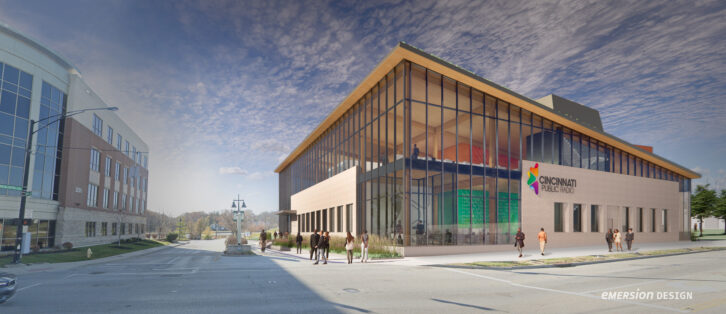
“The design team was tasked with creating a new home for our office and broadcast facilities,” said Vice President of Engineering Don Danko. He led the technical project working with CEO/General Manager Richard Eiswerth, COO Dan Smith and Chief Engineer Will Staffan.
“There are two on-air studios, two interview studios with corresponding control rooms, four edit pods, an audio audition pod, a podcast studio and a performance studio with an isolation booth, video control room and an audio control room.”
The images on these pages are renders. The project broke ground in the summer of 2023 and was slated for completion as this article was being finalized in early 2025. AV integration is scheduled for February and March, with move-in and a grand opening in April.
WSDG provided studio design, acoustics and AV. ProCraft Media executed the studio integration. The architects are Emersion Design, with construction by Skanska USA, structural engineering by Schaefer and mechanical, electrical and plumbing engineering by CMTA.

Audio infrastructure
“CPR adopted the Dante AoIP system a few years ago with the purchase of two SAS consoles,” Danko said.
“Since then, we replaced all the remaining consoles at our current facility.” The studios include new SAS consoles for on-air studios and two production studios to allow them to “flip a switch” and broadcast from the new building.
The consoles were ordered with a candy apple red frame that “pops” visually when a person enters the room. “After we sign on, we will be repurposing the existing consoles to edit studios and the podcast studio.”
Furniture is provided by Cabinet Works Unlimited. Its owner Ken Bagwell provided a lot of attention “to get the design correct and ensure things like wire management and cutouts for headphone controls and cough buttons were placed just right.”
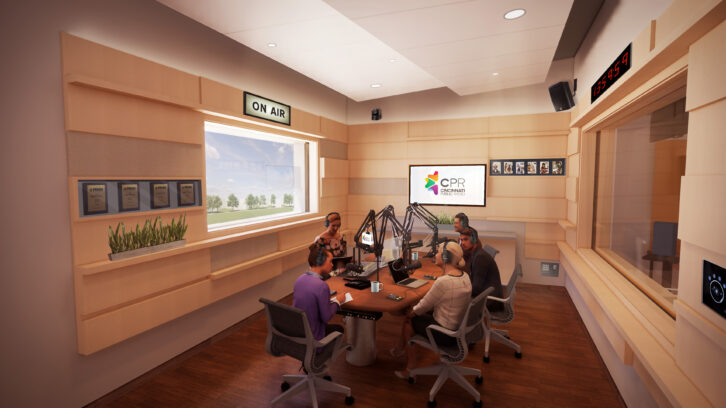
For audio processing, Danko said, “CPR has been using Omnia.9 processors for years and wanted to maintain that while also giving us the ability to activate more features within them. This required us to build out a Livewire system for transporting audio to the transmitter site and to the Omnia.9s, allowing us to utilize multiple processing cores.”
Working with both Dante and Livewire in the same building seemed like it would be complex, “but we believe it will allow us to tap into all the features of both systems with just a little extra effort to maintain them.”
For STL, GatesAir Intraplex codecs provide an 11 GHz point-to-point RF system and a redundant path via the internet.
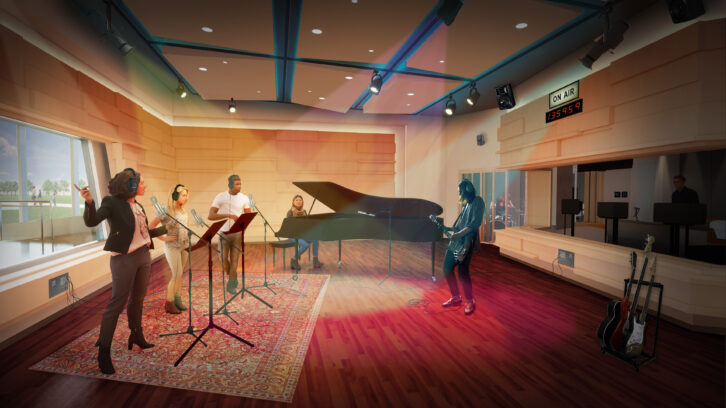
Customized on-air and recording lights provided by Procraft Media provide a glow of green LEDs around the studio name in the rest mode. “When the mic is turned on, a set of stunning red LEDs replace the green and also illuminates the RECORDING or ON AIR portion of the sign,” Danko said.
We asked whether the cloud and virtualization worked into this project. Danko said most of the impact is in backroom, non-broadcast computer systems.
“The trend to cloud-based software and services is gaining momentum and we plan to start adopting the technology, but right now we continue to use automation with a local server and workstations.” CRP’s next major project, after catching its breath from this one, is to replace its automation and live assist computer network.
Aesthetics
A new performance studio is intended to continue a long tradition of connecting the local arts community to Cincinnati Public Radio.
“CPR is one of only a few radio stations in the country that have a professional recording engineer on staff. The Cincinnati Symphony Orchestra and the Cincinnati Opera are just two of the many organizations we are contracted with to record, edit and produce performances. Many of those go on to be broadcast worldwide via syndicated shows and memorialized forever on CD.”
To ensure that this studio is state-of-the-art, they selected an Avid S6 console along with surround sound technology. It will have a stable of microphones from the classic U87 to new Neumann KM 184. CPR also owns a full Steinway D concert piano.
In planning aesthetics of the facility, Danko said designers sought to create a “glass envelope” to express openness and welcome as well as to infuse the interior with natural light. The design showcases natural wood elements of construction as much as possible.
The building is adjacent to a park and is meant to feel integrated with that public space. Visually, it is a simple pavilion with largely transparent exterior walls.
“The building design embodies CPR’s mission: embracing visual transparency to symbolize CPR’s commitment to be a trusted source of journalism, engaging the broader community — the gathering space and park integration welcomes visitors into the building — expressing the studio form as the heart of broadcast, and endeavoring to be good stewards of the environment.”
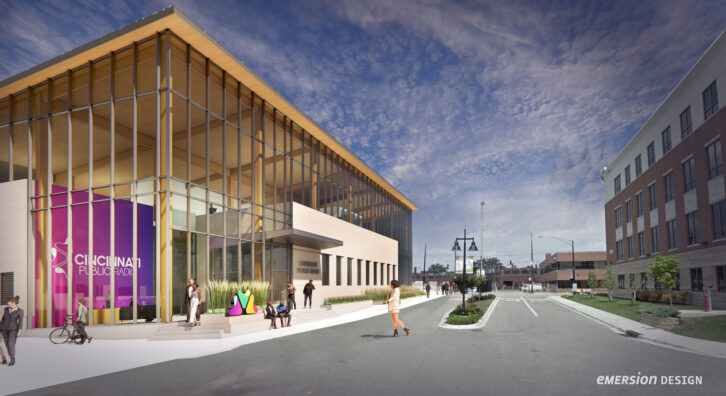
Danko said this is the first modern mass timber building in greater Cincinnati and perhaps the first mass timber broadcast facility in the nation. The mass timber structure was a driving element of the design, and this feature is highlighted throughout the building.
“The column grid remains largely exposed. Where there are partitions, they are pulled back from the columns, so the columns remain legible. The stairs are strategically located to display the cross-laminated timber shear walls, and enclosed spaces are pulled away from the glass to create light-filled open office areas.”
The use of natural materials, primarily the exposed mass timber, and daylighting are intended to improve the well-being of the occupants.
In the studios, he said, a panoply of acoustic treatment elements is intended to form a cohesive design strategy, one that has personality but can blend into the scene without distracting from the interviewees, musicians, community members and talent.
“CPR’s HQ has an overarching emphasis on quality, on responsibility,” Danko continued.
“The choice of sustainable materials was intentional and serves as a message for this forward-thinking, community-serving organization — providing studio spaces tailored to the content, i.e., interview spaces with a lot of light and glass to underscore transparency and connection to the outside world, spaces for music with high ceilings and quality materials that elevate the performer and the patron.”
